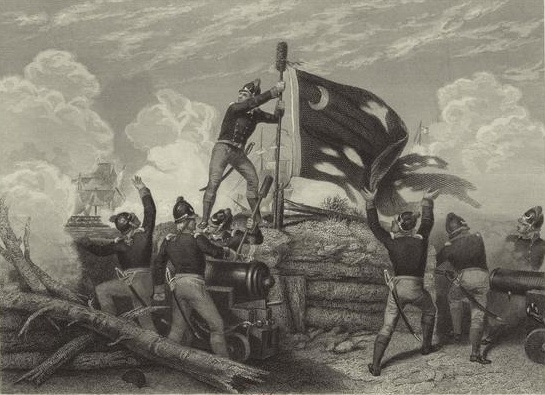 The Battle of Sullivan’s Island in South Carolina, was a decisive American victory over the British, on June 28, 1776. The outcome on Sullivan’s Island would prevent other British efforts in Charleston for over three more years, and it revived the American spirit. The pride of victory at Sullivan Island was initiative for more Americans to support the break from Great Britain, because the victory was achieved against all odds. Sullivan’s Island is now renamed, and known as Fort Moultrie in honor of Colonel William Moultrie’s success in defending Charleston.
The Battle of Sullivan’s Island in South Carolina, was a decisive American victory over the British, on June 28, 1776. The outcome on Sullivan’s Island would prevent other British efforts in Charleston for over three more years, and it revived the American spirit. The pride of victory at Sullivan Island was initiative for more Americans to support the break from Great Britain, because the victory was achieved against all odds. Sullivan’s Island is now renamed, and known as Fort Moultrie in honor of Colonel William Moultrie’s success in defending Charleston.
The Building of the Fort
John Rutledge, a member of the Continental Congress, delivered information of British plans to move into South Carolina in January, 1776. Rutledge organized defenses, under the command of Colonel William Moultrie, to be established on Sullivan’s Island. Sullivan’s Island was a strategically suitable place to construct a fort, because it was a geographic shield to the harbor. Vessels sailing into Charleston had to cross Charleston Bar, which consisted of submerged sand banks south of the city.
Colonel Moultrie and his regiment arrived at Sullivan’s Island in March to begin the construction of the defensive fort to protect the island and channel to Charleston Harbor. Late in May, British scouting ships arrived to observe the American fort, still in progress. By June 8, 1776, most of the British ships had anchored in Five Fathom Hole, and American General Charles Lee commanded the South Carolina troops to land forces around Charleston.
British Strategy
British General Henry Clinton sent word for American troops to surrender, or face British assault. Rutledge refused, although only half of the Sullivan Island fort was complete. His regiment was fairly untrained in arms assault. Confident that they could take the fort easily, the British fleet of nine ships arrived on Long Island, ready to cross the sandbar and attack Fort Sullivan from behind.
On June 2, 1776, American General Charles Lee arrived in Charleston, and ordered immediate fortifications elsewhere. General Lee was planning to abandon the unfinished fort, but Rutledge ordered him to defend and fortify it. Meanwhile, Major General Clinton commanded British forces to attack the northeastern end of Sullivan’s Island. Major Clinton was told incorrectly, that an assault could be carried across Breach Inlet. A search for a shallow ford to cross took the British fleets several days, and they found that it was not a proper route for attack. This gave an upper hand to the Americans.
On June 26, the British repositioned at Five Fathom Hole, ready for the assault, and on June 27, Major General Clinton put British troops ashore Long Island, north of Sullivan’s Island. Sullivan’s Island was on the island’s southern tip, so Clinton found it hard for his fleets to cross the Breach from Long Island to Sullivan’s Island. While searching for a place to cross, guns had to be removed from two of the British warships in order to make them light enough to clear the bar.
The Attack
On June 28, 1776, Admiral Peter Parker commanded twenty British ships to move in closer, and with a change in tide, the ships ran aground, with only nine of the twenty ships armed. The American regiments poured accurate, deadly fire into the British fleets. Cannonball assaults were made by the British, but because the fort was constructed of soft and spongy Palmetto wood, the assaults were absorbed into the wood. The inexperienced and unprepared Americans managed to thwart British attack efforts at both ends of the island under the command of Colonel Moultrie, and the British halted their attacks later in the day.
The Aftermath
Sullivan’s Island was the first decisive American victory, where defeat seemed inevitable for the Americans from the beginning. Due to incorrect information presented to the British commanders, incorrect strategic placement of British fleets, and the courage of American troops to proceed with precision, Americans prevented British challenge to Charleston for another three years. The victory at Sullivan’s Island united Americans with the pride of success in protecting Charleston, even with the odds against them.